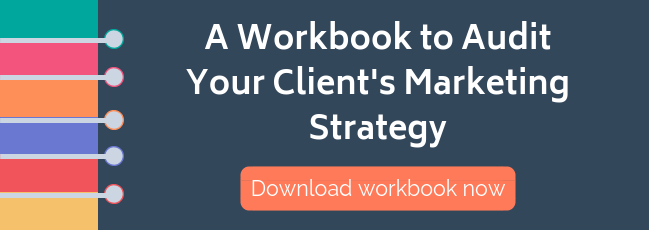What is a client? Who is an ideal client?

There are a seemingly endless number of marketing and advertising agencies for clients to choose from. And because most of these offer similar services, it's easy for clients to quickly switch from one firm to another.
One way to escape this "sea of sameness" is with strong positioning and branding of your agency. But defining your differentiating factors is just the first step; creating an ideal client profile should be the second. According to the Marketing Agency Growth Report 2018, acquiring new clients has been one of the big pain points for almost 60% of the agencies and 16% of them face client retention problems.
Download Now: 8 Free Customer Profile Templates
Adapting to the client’s pricing preference is another layer of complexity demanded by clients that an agency owner must deal with in today’s market. While 79% of agency owners are confident about closing new deals and clients, 23% of them fail to meet client goals and expectations. In order to drive clients to your agency, considering to offer incentives in the form of discounts, bonus work, faster turnarounds have worked out well for agencies.
Benefits of Defining an Ideal Client Profile
What is the Purpose of a Client Profile?
A client profile is a focused sales strategy that tells you which potential clients are actually good prospects -- and which ones aren't. With this information you can build marketing materials that are relevant to only your best types of clients, and learn to go after and sell to these valuable brands, which will save your agency time, money, and effort. The benefits of defining an ideal client profile are: Personalization, Content Creation & Mapping, Segmentation, Keyword Research, Sales Process.
1) Personalization
If you specialize in different service lines or industries, you can use personalization based on client profiles to customize your website to that group’s specific needs.
A report from Venture Beat found that 70% to 94% of marketers have seen increases in key site performance indicators such as sales by employing personalization.
2) Content Creation & Mapping
Once you know your ideal client profiles, you can create content that will engage those prospects and clients -- whether this is a blog post, ebook, or sales enablement tool.
You can then align your content by ideal client profile and lifecycle stage or where in the buying journey the prospect is. You’ll want to write and package content differently depending on if the potential client is simply getting to know your agency, has been in contact with your business development team, or has a proposal sitting on her desk.
3) Segmentation
Personalized emails can improve click-through rates by 14% and conversions by 10%, and drive 18 times more revenue than broadcast emails. With distinct idea client profiles, you can segment your list and create campaigns that align with their buying process. You can also use these lists to segment by prospects and current clients, so you can market either new services or additional service lines. You could also create email drip campaigns based on if you have had an initial meeting with the client or if the client has been sent a proposal to future the relationship.
4) Keyword Research
Once you know how your ideal clients are searching and the language they use, you can create targeted articles that will be indexed by search engines and found by prospects during their search process. This could also help you to identify a target list of publications you want to pitch and potential partners you could advertise with.
5) Sales Process
The client profile will give you a better understanding of how your ideal client makes decisions, what sources they ask for recommendations, how they find an agency partner, and the average sales cycle for each type. Using this information, you can mold your sales process to your prospects. This will help you to better understand when a proposal is actually necessary, what type of nurturing campaigns you should set up, what information the prospect needs and when, and how often you should communicate with the potential client.
Creating an ideal client profile -- or a few -- will help you to attract, qualify, and sell to only these clients. And this is how you can truly stand out from the competition.
Once you complete your ideal client profile(s), you’ll be able to use these marketing activities in a more informed and relevant way.
How to Create an Ideal Client Profile
An ideal client profile should be based on interviews and research from your current and past clients, prospects, and your staff. The end result is that you create a fictional character whom embodies your best client, but the information and data needs to be based in reality.
Follow these three simple steps to create an ideal client profile:
How to Create a Client Profile
1) Make a List of Your Best Clients
To find your five or 10 best customers, consider these questions:
- What are your most profitable accounts?
- Which clients have been with your agency within the range of or past your average client lifespan?
- Which clients signed on with your agency within or below the normal sales cycle range?
- Does the client delay projects, or do they provide feedback promptly and clearly?
- Does the client pay within your acceptable collection period?
- Do you like working with the client?
- Is the work fulfilling?
- Does the client provide positive and constructive feedback?
- Do you provide a high ROI delivering the services requested by the client?
You could also dig into your analytics data -- from Google analytics, your marketing automation platform, or CRM -- to see if you can align website behavior to your current “best” clients, such as how submissions on a landing page align with a job titles or which roles consume which type of content.
2) Conduct Client Interviews
These interviews should help you gather both qualitative and quantitative information that will balance out your information and help you create useful client profiles. Ideally, doing these in-person will provide you with the best information, but you could also use a survey tool to gather this data.
Here’s an extensive list of questions you can ask to extract the information you need for the eight main categories that will be used in the client profile template. Feel free to remove or add additional questions based on what is most important to your agency.
Decision Maker Information
- What is your role?
- How long have you been at the company? How long were you employed at your previous role?
- What skills are required to do your job?
- What tools do you use in your job?
- Who do you report to? Who reports to you?
- What does a typical day look like?
- What people in your company make decisions about selecting a marketing agency or technology vendor?
Company Data
- In which industry or industries does your company work?
- What is the size of your company (revenue, employees)?
- Where are you located?
- What is your marketing budget per year?
- What percentage of this is used on outside resources -- agencies, vendors, freelancers?
- How many in-house marketers do you employ?
- What does your sales cycle look like?
Goals & Challenges
- What are your job responsibilities and priorities?
- How is your job measured?
- What does it mean to be successful in your role?
- What are your biggest challenges? important successes?
Information Search Process
- What sites and publications do you frequently visit to learn new information for your job?
- What associations or groups do you belong to? What conferences do you attend?
- What social networks do you use and how do you use them?
- How do you begin the search for a new agency? Do you search for a company on Google? If so, what keywords do you use? Do you use an agency search firm or an online database?
Identifiers
- How do you handle conflict?
- Do you like to work independently or in a group?
- What style of communication works best for you?
Objections
- Why is it difficult to work with an agency? Why would you want to bring the work in-house?
- During the sales process, what points about our firm made you hesitant to work with us?
- Where did you turn to find out information about our agency from other sources?
Purchasing Decisions
- Why did you decide to work with our agency?
- Why have you stayed with use for X years?
- What did the decision process look like for your team?
- How are we unique from other agencies you have worked with?
- What are three important qualities you look for in an agency?
3) Compile the Information & Create Your Profiles
When you’re done, you will take this information and create a profile that follows the outline in this ideal client profile template:
- Background
- Demographics
- Personality/communication style
- Goals
- Challenges and how the agency can address these challenges
- Objections
- Purchasing process
- Agency’s fit or elevator pitch to this specific segment
You should create a detailed, in-depth client profile for review by your marketing team, sales team, account managers, strategists, etc. You could also create a shorter, more visual version to make it easy to remember and identify your ideal client profile.
Agency New Business
